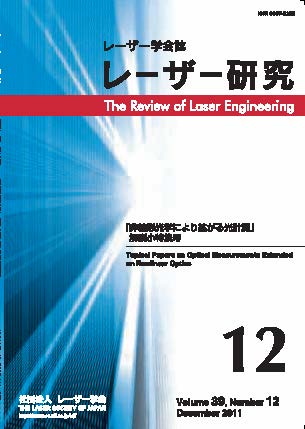All issues

Volume 49, Issue 5
Special Issues on Recent Progress on Living-Cell Imaging for Analysis of Cell Functions
Displaying 1-7 of 7 articles from this issue
- |<
- <
- 1
- >
- >|
Special Issues on Recent Progress on Living-Cell Imaging for Analysis of Cell Functions
Special Issue
Laser Review
-
Yoshimasa KAWATA2021Volume 49Issue 5 Pages 264-
Published: 2021
Released on J-STAGE: April 11, 2024
JOURNAL FREE ACCESSThis paper describes the overview of special issues for the recent progress and developments on living- cell imaging technique for analysis of cell functions. The topics of this issues covers digital holography for imaging of phase object, super resolution imaging with laser scanning confocal microscope, nonlinear Raman scattering, multi-spectrum stimulated Raman scattering, a new type annular illumination technique for phase objects, near-infrared hyper spectrum imaging. Key Words: Optical microscopy, Live cell imaging, Super resolution, FunctionalView full abstractDownload PDF (209K) -
Osamu MATOBA, Manoj KUMAR, Xiangyu QUAN, Yasuhiro AWATSUJI2021Volume 49Issue 5 Pages 266-
Published: 2021
Released on J-STAGE: April 11, 2024
JOURNAL FREE ACCESSIn bioimaging, such non-invasive and non-destructive multi-dimensional information as fluorescence, phase, spectra, and polarization are very helpful for understanding the behavior and activity of living cells. In this review article, we present a simultaneous single-shot recording technique of three-dimensional fluorescence and phase distributions based on digital holography for living-cell imaging. In both fluorescence and phase measurements, a common-path off-axis incoherent digital holography and a common- path off-axis digital holography have been developed for stable time-lapse measurements. As a feasibility measurement, fluorescence beads and plant cells are presented.View full abstractDownload PDF (1080K) -
Kazuo KUROKAWA, Daisuke MIYASHIRO, Akihiko NAKANO2021Volume 49Issue 5 Pages 271-
Published: 2021
Released on J-STAGE: April 11, 2024
JOURNAL FREE ACCESSIn order to directly visualize the events occurring in living cells, a cutting-edge technology has been long awaited that enables simultaneous multi-color and four-dimensional observation with high spatial and temporal resolution. Super-resolution microscopy methods so far available, for example, stimulated emission depletion microcopy (STED), photoactivated localization microscopy/stochastic optical reconstruction microscopy (PALM/STORM), and Structured illumination microscopy (SIM), provide great spatial resolution, but are not sufficient in temporal resolution for live cell imaging. We have developed a unique technology, the super-resolution confocal live imaging microscopy (SCLIM), which achieves the performance required. In the field of cell biology, a big debate arose between two models for explaining cargo transport across the Golgi apparatus: the vesicular transport model and the cisternal maturation model. By using SCLIM, we have conducted simultaneous 3-color high-spatiotemporal visualization of secretory cargo together with early and late Golgi resident proteins. Secretory cargo is indeed delivered within the Golgi by cisternal maturation.View full abstractDownload PDF (756K) -
Shinichi MIYAZAKI, v HAYASHI, Hideaki KANO2021Volume 49Issue 5 Pages 276-
Published: 2021
Released on J-STAGE: April 11, 2024
JOURNAL FREE ACCESSSpectroscopic imaging unveils what kinds of biomolecules exist in cells, tissues, or animals. Coherent anti-Stokes Raman scattering (CARS) spectroscopic imaging enables us to obtain molecular information in a living model organism, Caenorhabditis elegans. The microspectroscopic system employs a new laser source based on the dual-fiber-output configuration, which generates 50-ps laser pulses with 1 MHz repetition rate. The system enables us to conduct label-free spectroscopic imaging in vivo. Spectroscopic imaging has the potential to uncover crucial questions in life sciences.View full abstractDownload PDF (1202K) -
Yasuyuki OZEKI2021Volume 49Issue 5 Pages 281-
Published: 2021
Released on J-STAGE: April 11, 2024
JOURNAL FREE ACCESSWe present multicolor imaging of cells in a high-speed flow with molecular vibrational contrast based on stimulated Raman scattering (SRS). By using a newly developed wavelength-switchable laser, four-color SRS imaging is accomplished with an unprecedented pixel rate of 4.75 Mpixels/s. This SRS imaging system was integrated with a microfluidic chip equipped with an acoustophoretic focuser to realize four-color SRS imaging at a flow speed of 2 cm/s. In this paper, we introduce the principles of SRS imaging, SRS flow cytometer, and wavelength-switched lasers, and then demonstrate multicolor SRS imaging of polymer beads and microalgal cells.View full abstractDownload PDF (834K) -
Yoshimasa SUZUKI2021Volume 49Issue 5 Pages 286-
Published: 2021
Released on J-STAGE: April 11, 2024
JOURNAL FREE ACCESSWe proposed a microscopy method for observing phase objects without halos or directional shadows. The key optical element is an annular aperture at the front focal plane of a condenser with a larger diameter than one used in standard phase contrast microscopy. The light flux passing through the annular aperture is changed by the specimen’s surface profile, and then it passes through an objective and contributes to image formation. Images of colonies, formed by induced pluripotent stem (iPS) cells using this method, are compared with the conventional phase contrast method. Our method obtains phase images of iPS cell colonies with clear outlines and their three-dimensional natureView full abstractDownload PDF (926K) -
Toshihiro TAKAMATSU, Hiroaki IKEMATSU, Hiroshi TAKEMURA, Hideo YOK ...2021Volume 49Issue 5 Pages 291-
Published: 2021
Released on J-STAGE: April 11, 2024
JOURNAL FREE ACCESSIt is well known that near-infrared (NIR) spectrum have high transparency to living organisms than visible light and ultraviolet light, because there is less absorption and light scattering. In particular, the over 1000 nm wavelength is a weak absorption region of overtone and combination tone of molecular vibrations, thus, spectrum information of the deep tissue composition can be obtained. Hyperspectral imaging (HSI) is the modality that can provide spectroscopic information with high spatial resolution. Therefore, these technologies are focused on medical field. Recently, it is reported that visual assistance such as diagnosis of deep lesion and surgical navigation, which are difficult to recognize by visible light, can be performed using these combined NIR-HSI. In this paper, the medical applications of NIR-HSI and development for endoscope are introduced.View full abstractDownload PDF (2152K)
- |<
- <
- 1
- >
- >|